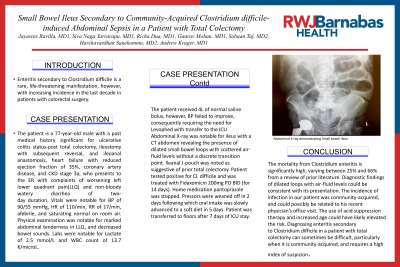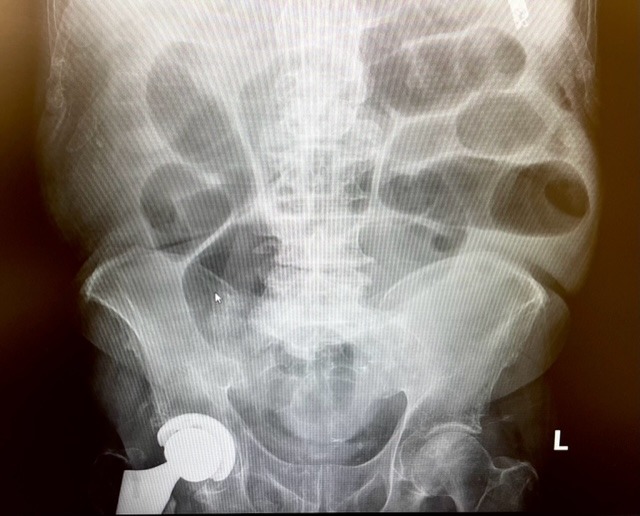Tuesday Poster Session
Category: Small Intestine
P4177 - Small Bowel Ileus Secondary to Community-Acquired Clostridium difficile-induced Abdominal Sepsis in a Patient with Total Colectomy
Tuesday, October 24, 2023
10:30 AM - 4:00 PM PT
Location: Exhibit Hall

Has Audio
- SY
Siva Naga Srinivas Yarrarapu, MD
Monmouth Medical Center/RWJBH
Long Branch, NJ
Presenting Author(s)
Jayasree Ravilla, MD1, Siva Naga Srinivas Yarrarapu, MD1, Richa Dua, MBBS2, Gaurav Mohan, MD1, Sobaan Taj, MD3, Harshavardhan Sanekommu, MD3, Andrew Kruger, MD1
1Monmouth Medical Center/RWJBH, Long Branch, NJ; 2Monmouth Medical Center, Long Branch, NJ; 3Hackensack Meridian Jersey Shore University Medical Center, Neptune, NJ
Introduction: Enteritis secondary to Clostridium difficile is a rare, life-threatening manifestation, however, with increasing incidence in the last decade in patients with colorectal surgery.
Case Description/Methods: Patient is a 77-year-old male with a past medical history significant for ulcerative colitis status-post total colectomy, ileostomy with subsequent reversal, and ileoanal anastomosis, heart failure with reduced ejection fraction of 35%, coronary artery disease, and CKD stage 3a, who presents to the ER with complaints of worsening left lower quadrant pain(LLQ) and non-bloody watery diarrhea of two-
day duration. Vitals were notable for BP of 90/55 mmHg, HR of 110/min, RR of 17/min, afebrile, and saturating normal on room air. Physical examination was notable for marked abdominal tenderness in LLQ, and decreased bowel sounds. Labs were notable for Lactate of 2.5 mmol/L and WBC count of 13.7 K/microL. The patient received 4L of normal saline bolus, however, BP failed to improve, consequently requiring the need for Levophed with transfer to the ICU. Abdominal X-ray was notable for ileus with a CT abdomen revealing the presence of dilated small bowel loops with scattered air-fluid levels without a discrete transition point. Ileanal J-pouch was noted as suggestive of prior total colectomy. Patient tested positive for Cl. difficile and was treated with Fidaxomicin 200mg PO BID (for 14 days). Home medication pantoprazole was stopped. Pressors were weaned off in 2 days following which oral intake was slowly advanced to a soft diet in 5 days. Patient was transferred to floors after 7 days of ICU stay.
Discussion: The mortality from Clostridium enteritis is significantly high, varying between 25% and 66% from a review of prior literature. Diagnostic findings of dilated loops with air-fluid levels could be consistent with its presentation. The incidence of infection in our patient was community-acquired, and could possibly be related to his recent physician’s office visit. The use of acid suppression therapy and
increased age could have likely elevated the risk. Diagnosing enteritis secondary to Clostridium difficile in a patient with total colectomy can sometimes be difficult, particularly when it is community-acquired, and requires a high index of suspicion.

Disclosures:
Jayasree Ravilla, MD1, Siva Naga Srinivas Yarrarapu, MD1, Richa Dua, MBBS2, Gaurav Mohan, MD1, Sobaan Taj, MD3, Harshavardhan Sanekommu, MD3, Andrew Kruger, MD1. P4177 - Small Bowel Ileus Secondary to Community-Acquired Clostridium difficile-induced Abdominal Sepsis in a Patient with Total Colectomy, ACG 2023 Annual Scientific Meeting Abstracts. Vancouver, BC, Canada: American College of Gastroenterology.
1Monmouth Medical Center/RWJBH, Long Branch, NJ; 2Monmouth Medical Center, Long Branch, NJ; 3Hackensack Meridian Jersey Shore University Medical Center, Neptune, NJ
Introduction: Enteritis secondary to Clostridium difficile is a rare, life-threatening manifestation, however, with increasing incidence in the last decade in patients with colorectal surgery.
Case Description/Methods: Patient is a 77-year-old male with a past medical history significant for ulcerative colitis status-post total colectomy, ileostomy with subsequent reversal, and ileoanal anastomosis, heart failure with reduced ejection fraction of 35%, coronary artery disease, and CKD stage 3a, who presents to the ER with complaints of worsening left lower quadrant pain(LLQ) and non-bloody watery diarrhea of two-
day duration. Vitals were notable for BP of 90/55 mmHg, HR of 110/min, RR of 17/min, afebrile, and saturating normal on room air. Physical examination was notable for marked abdominal tenderness in LLQ, and decreased bowel sounds. Labs were notable for Lactate of 2.5 mmol/L and WBC count of 13.7 K/microL. The patient received 4L of normal saline bolus, however, BP failed to improve, consequently requiring the need for Levophed with transfer to the ICU. Abdominal X-ray was notable for ileus with a CT abdomen revealing the presence of dilated small bowel loops with scattered air-fluid levels without a discrete transition point. Ileanal J-pouch was noted as suggestive of prior total colectomy. Patient tested positive for Cl. difficile and was treated with Fidaxomicin 200mg PO BID (for 14 days). Home medication pantoprazole was stopped. Pressors were weaned off in 2 days following which oral intake was slowly advanced to a soft diet in 5 days. Patient was transferred to floors after 7 days of ICU stay.
Discussion: The mortality from Clostridium enteritis is significantly high, varying between 25% and 66% from a review of prior literature. Diagnostic findings of dilated loops with air-fluid levels could be consistent with its presentation. The incidence of infection in our patient was community-acquired, and could possibly be related to his recent physician’s office visit. The use of acid suppression therapy and
increased age could have likely elevated the risk. Diagnosing enteritis secondary to Clostridium difficile in a patient with total colectomy can sometimes be difficult, particularly when it is community-acquired, and requires a high index of suspicion.

Figure: Abdominal X-ray demonstrating Small bowel ileus
Disclosures:
Jayasree Ravilla indicated no relevant financial relationships.
Siva Naga Srinivas Yarrarapu indicated no relevant financial relationships.
Richa Dua indicated no relevant financial relationships.
Gaurav Mohan indicated no relevant financial relationships.
Sobaan Taj indicated no relevant financial relationships.
Harshavardhan Sanekommu indicated no relevant financial relationships.
Andrew Kruger indicated no relevant financial relationships.
Jayasree Ravilla, MD1, Siva Naga Srinivas Yarrarapu, MD1, Richa Dua, MBBS2, Gaurav Mohan, MD1, Sobaan Taj, MD3, Harshavardhan Sanekommu, MD3, Andrew Kruger, MD1. P4177 - Small Bowel Ileus Secondary to Community-Acquired Clostridium difficile-induced Abdominal Sepsis in a Patient with Total Colectomy, ACG 2023 Annual Scientific Meeting Abstracts. Vancouver, BC, Canada: American College of Gastroenterology.
